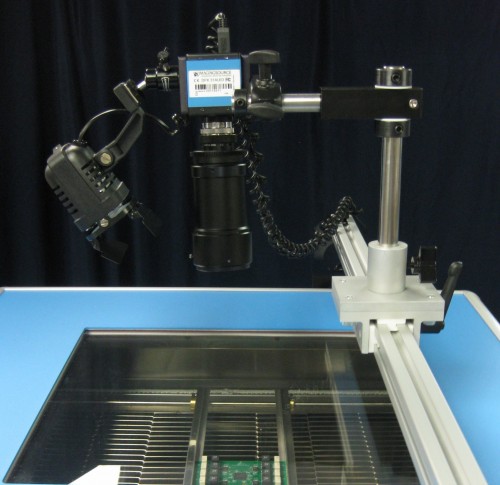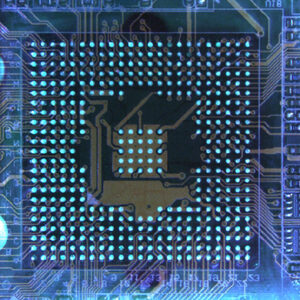Applications For BGA Rework, Reflow Soldering, Die Bonding,
And Stress Testing Of Microvias
- Wafer Level Chip Scale Package (WLCSP) Desoldering and Installation
- Micro BGA (4 BGA, 0.8mm x 0.8mm, 0.4mm pitch) – Placement and Soldering
- QFN / MLF Rework
- Micro BGA / CSP Rework
- Reflow Soldering with Video Recording and Observation module
- Fine Pitch Connector Rework
- Fine Pitch QFP 208 Rework
- CSP / µBGA Rework
- BGA Removal and Installation
- Flip Chip Installation
- Thermal Stress – Convection Reflow Assembly Simulation per IPC-TM-650 Test Method 2.6.27
- Automating Reflow of Surface Mount Devices per IPC / JEDEC J-STD-020 for Classification and Preconditioning
- Solder Paste Printing Directly to LGA (Land Grid Array) and MLF / QFN (Quad Flat No-Leads) Packages
- SMD & BGA Rework Process
Wafer Level Chip Scale Package (WLCSP) Desoldering and Installation
Wafer Level Chip Scale Package (WLCSP) being removed and soldered on a PCB using an ATCO AT-GDP SMD / BGA Rework Station. WLCSP measures 1.5mm x 1.5mm with a 0.4mm pitch.
Micro BGA (4 BGA, 0.8mm x 0.8mm, 0.4mm pitch) - Placement and Soldering
Rework of a 4 – ball Wafer Level Chip Scale Package (WLCSP) measuring 0.8mm x 0.8mm from a 7mm x 6mm PCB substrate. The 4 solder balls that are 0.26mm in diameter with 0.4mm pitch. The desoldering and installation process was performed using the ATCO AT-GDP SMD / BGA Rework Station.
Reflow Soldering with Video Recording and Observation module

Upgraded video observation module for PRO 1600 Reflow Oven now allows taking still images and recording video during a reflow cycle. Camera may be focused and magnified at the solder paste joint level thereby providing visual feedback during the soldering process. Primary benefit of this feature is analysis and study of behavior of solder paste and SMT components during reflow soldering. It helps to identify, analyze, and ultimately to prevent defects.
The module includes a dual panel 16” X 16” high temperature rated glass cover, high resolution camera with optical and digital zoom, lighting system, multi-angle adjustable camera mounting, and an advanced Imaging Capture software.

CSP / µBGA Rework
Introduction
Also referred to as micro BGA’s, Chip Scale Packages (CSP) although similar to traditional BGA components differ in overall size and diameter of solder spheres. Their size is typically smaller and solder spheres are about ½ the diameter of BGA’s which range from 0.55mm to 0.75mm. This article details rework of a CSP on a test board using an AT-GDP Rework Station. A Lead Free profile has been applied during removal and installation processes.
Components
The CSP measures 7mm x 6mm and contains 46 spheres (Figure 1). Solder spheres measure 0.35mm in diameter with a pitch of 0.75mm. Test board measures 70mm x 165mm.
Removal
After securing the test board by the board holder’s clamps, an operator installs a vacuum pick up tip and nozzle suitable for the CSP device. Implementing machine’s optics, the nozzle is aligned over the component. A pre-established profile is selected from the software’ library and Start icon is selected. At this point the process is hands-off. Rework station automatically drives the nozzle down to a board and covers the CSP.
Machine then activates vacuum pick up tip so as to remove the component once reflow is achieved and the heating cycle is initiated. Figure 2 shows a nozzle covering the device during reflow. Heating is precisely controlled by the software (Figure 3). It mimics an original profile with heat applied from both top and bottom sides of a board. Source of bottom heating is Quartz IR while the top side is forced air or nitrogen convection. As is shown in the video of removal, upon completion of reflow, the machine lifts a CSP off a board and moves nozzle up along Z axis to its starting point. Figure 2: Nozzle covering CSP during reflow Figure 3: Screenshot of a profile Residual solder remains on the board after removing a component. It takes the shape of Hershey’s kisses candy due to surface tension of molten solder (Figure 4). As a result of its uneven shape and volume, solder must be removed prior to installing a new component. This is commonly performed using a solder wick method.
BGA Removal and Installation
Introduction
Components

Removal
After securing the motherboard by the board holder’s clamps, an operator installs a vacuum pick up tip and nozzle suitable for the BGA device. Implementing machine’s optics, the nozzle is aligned over the component. A pre-established profile is selected from the software’ library and Start icon is selected. At this point the process is hands-off. Rework station automatically drives the nozzle down to a board and covers the BGA. Machine then activates vacuum pick up tip so as to remove the component once reflow is achieved and the heating cycle is initiated. Figure 2 shows a nozzle covering the device during reflow.
Heating is precisely controlled by the software (Figure 3). It mimics an original profile with heat applied from both top and bottom sides of a board. Source of bottom heating is Quartz IR while the top side is forced air or nitrogen convection. As is shown in the video of removal, upon completion of reflow, the machine lifts a BGA off a board and moves nozzle up along Z axis to its starting point.


Residual solder remains on the board after removing a component. It takes the shape of Hershey’s kisses candy due to surface tension of molten solder. As a result of its uneven shape and volume, solder must be removed prior to installing a new component (Figure 4). This may be accomplished by using a vacuum de-soldering tool or more commonly by wicking solder with a copper braid and soldering iron.

Installation






Conclusion
In order to properly rework a BGA component, the rework station must contain features like split vision optics, software controlled sequencing and thermal management, and automation. These features not only simplify the process but also enable achieving high quality results on a consistent basis.
Flip Chip Installation
Introduction
An increase in implementation of Flip Chips, Dies, and other micro SMD devices with hidden joints within PCB and IC assembly sectors requires capability to precisely install and rework such devices. This article details the installation process of a Flip Chip onto a BGA IC substrate using an AT-GDP Rework Station. A Eutectic Soldering process is being applied.
Components
The Flip Chip measures 8.25mm x 6mm while the BGA substrate is 35mm x 35mm (Figure 1). Flip Chip contains 560 solder bumps with each bump measuring 65μm in diameter and the pitch is as fine as 180 μm. Figure 2 shows an actual image of a Flip Chip captured on the AT-GDP Rework Station’s camera view screen. Figure 3 displays the corresponding pads on a BGA substrate.
Thermal Stress - Convection Reflow Assembly Simulation per IPC-TM-650 Test Method 2.6.27
The purpose of this paper is to demonstrate the reflow process of thermal stress reflow simulation on bare PCB’s per IPC-TM-650 Test Method 2.6.27 (Thermal Stress, Convection Reflow Assembly Simulation). This standard requires PCBs or test coupons to be reflowed six (6) times and then evaluated for quality compliance. Each of the six reflow cycles must be nearly identical to one another in order to maintain the profile tolerances specified in the standard. By automating the six cycles within a reflow oven, consistency is attainable, chance of operator errors that may invalidate the test are eliminated, and efficiency greatly improved.
Automating Reflow of Surface Mount Devices per IPC / JEDEC J-STD-020 for Classification and Preconditioning
The purpose of this paper is to demonstrate the reflow soldering process on Surface Mount Devices (SMD) per IPC / JEDEC J-STD-020D.1. SMD suppliers subject their products to this test for classification and preconditioning (JESD22-A113F) purposes. This standard requires SMDs to be reflowed three (3) times and then evaluated for quality compliance. Each of the three reflow cycles must be nearly identical to one another in order to maintain the profile tolerances specified in the standard. By automating the three cycles within a reflow oven, consistency is attainable, chance of operator errors that may invalidate the test are eliminated, and efficiency greatly improved.
Solder Paste Printing Directly to LGA (Land Grid Array) and MLF / QFN (Quad Flat No-Leads) Packages
Unlike Ball Grid Arrays (BGA), Land Grid Array (LGA) and Quad Flat No-Leads (QFN) packages are supplied with bare plated contact pads and solder must be used in the assembly or rework process to install such components. There are several methods of how solder may be applied such as paste printed on the PCB, pre-tinned on the package, or applied directly to the package prior to reflow. The benefit of applying solder paste directly to the package versus pre-tinning is that it reduces processing time, eliminates unnecessary handling, and does not subject a part to an additional thermal cycle. This guide outlines step by step procedure of solder paste being transferred directly to an LGA device prior to being optically aligned and soldered using the AT-GDP SMD/BGA Rework Station.
